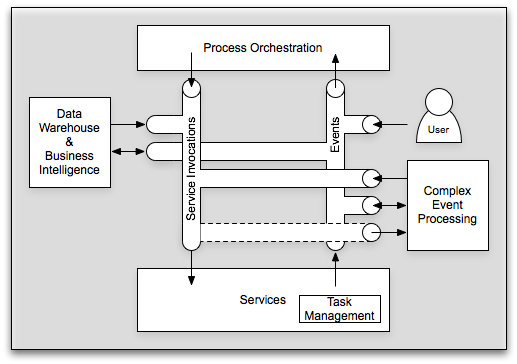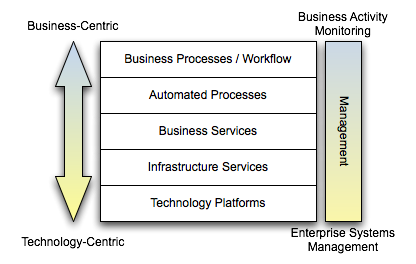Archive for the ‘BAM’ Category
 Gaining Visibility
Gaining Visibility
While I always take vendor postings with a grain of salt, David Bressler of Progress Software had a very good post entitled, “We’re Running Out of Words II.” Cut through the vendor-specific stuff, and the message is that routing all of your requests through a centralized process management hub in order to gain visibility may not be a good thing. In his example, he tells the story of a company that took some existing processes and, in order to gain visibility into the execution of the process steps, externalized the process orchestration into a BPM tool. In doing so, the performance of the overall process took a big hit.
To me, scenarios like this are indicative of one major problem: we don’t think about management capabilities. Solution development is overwhelmingly focused on getting functional capabilities out the door. Obviously, it should be, but more often than not there is no instrumentation. How can we possibly claim that a solution delivers business value over time if there is no instrumentation to provide metrics? Independent of whether external process management is involved, gateway-based interception is used versus agent-based approaches, etc. we need to begin with the generation of metrics. If you’re not generating metrics, you’re going to have poor, or even worse, no visibility.
Unfortunately, all too often, we’re only focused on problem management and resolution, and the absence of metrics only comes to light if something goes wrong and we need to diagnose the situation. To this, I come back to my earlier statement. How can we have any confidence in saying that things are working properly and providing value without metrics?
Interestingly, once you have metrics, the relationships (and potentially collisions) between the worlds of enterprise system management, business process management, web service management, business activity monitoring, and business intelligence start to come together, as I’ve discussed in the past. I’ve seen one company take metrics from a BPM tool and placing them into their data warehouse for analysis and reporting from their business intelligence system. Ultimately, I’d love to see a differentiation based upon what you do with the data, rather than on the mere ability to collect the data.
 Acronym Soup
Acronym Soup
The panel discussion I was involved with at The Open Group Enterprise Architecture Practitioner’s Conference went very well, at least in my opinion. We (myself, our moderator Dana Gardner, Beth Gold-Bernstein, Tony Baer, and Eric Knorr) covered a range of questions on the future of SOA, such as when will we know we’re there, will we still be discussing it 5 years from now or will it be subsumed by EA as a whole, etc.
In our preparations for the panel, one of the topics that was thrown out there was how SOA will play with BPM, EDA, BI, etc. I should point out that our prep call only set the basic framework of what would be discussed, we didn’t script anything. It was quite difficult biting my tongue on the prep call as I wanted to jump right into the debate. Anyway, because it didn’t get the depth of discussion that I was expecting, I thought I’d post some of my thoughts here.
I’ve previously posted on the integration between SOA, BPM, Workflow, and EDA, or probably better stated, services, processes, and events. There are people who will argue that EDA is simply part of SOA, I’m not one of them, but that’s not a debate I’m looking to have here. It’s hard to argue that there are natural connections between services, processes, and events. I just recently posted on BI and SOA. So, it’s time to try to bring all of these together. Let’s start with a picture:

In its simplest form, I still like to begin with the three critical components: processes, services, and events. Services are explicitly invoked by sending a service invocation message. Processes are orchestrated through a sequence of events, whether human-generated or machine generated. Services can return responses, which in essence are a “special” event directed solely at the requestor, or they can publish events available for general listening. So, we’ve covered SOA, BPM, EDA, and workflow. To bring in the world of EDW (Enterprise Data Warehouse), BI (Business Intelligence), CEP (Complex Event Processing), and even BAM (Business Activity Monitoring, although not shown on the diagram), the key is using these messages for purposes other than which they were intended. CEP looks at all messages and is able to provide a mechanism for the creation of new events or service invocations based upon an analysis of the message flow. Likewise, take these same messages and let them flow into your data warehouse and allow your business intelligence to perform some complicated analytics on them. You can almost view CEP as a sort of analytical engine operating on a small window, while business intelligence can act as the analytical engine operating on a large window. Just with CEP, your EDW and BI system can (in addition to report) generate events and/or service invocations. Simply put, all of the technologies associated with all of these acronyms need to come together in a holistic vision. At the conference, Joe Hill from EDS pointed out that when many of these technologies solved 95% of the problem they were brought in for. Unfortunately, when your problem space is broadened to where it all needs to integrate, the laws of multiplication no longer apply. That is, if you have two solutions that solved 95% of their respective problems, they don’t solve 0.95 * 0.95 = 90.25% of the combined problem. Odds are that combined problem falls into the 5% that neither of them solved on their own.
It is the responsibility of enterprise architecture to start taking the broader perspective on these items. The bulk of the projects today are still going to be attacking point problems. While those still need to be solved, we need to ensure that these things fit into a broader context. I’m willing to bet that most service developers have never given thought to whether the service messages could be incorporated into a data warehouse. It’s just as unlikely that they’re publishing events and exposing some potentially useful information for other systems, even where their particular solution didn’t require any events. So, to answer the question of whether SOA will be a term we use 5 years from now, I certainly hope we’re still using it, however, I hope that it’s not still as some standalone initiative distinct from other enterprise-scoped efforts. It all does need to fall under the umbrella of enterprise architecture, but that doesn’t mean that the EA still doesn’t need to be talking about services, events, processes, etc.
Update: I redid the picture to make it clearer (hopefully).
 The management continuum
The management continuum
Mark Palmer of Apama continued his series of posts on myths around the EDA/CEP space, with number 3: BAM and BPM are Converging. Mark hit on a subject that I’ve spoken with clients about, however, I don’t believe that I’ve ever posted on it.
Mark’s premise is that it’s not BAM and BPM that are converging, it’s BAM and EDA. Converging probably isn’t the right word here, as it implies that the two will become one, which certainly isn’t the case. That wasn’t Mark’s point, either. His point was that BAM will leverage CEP and EDA. This, I completely agree with.
You can take a view on our solutions like the one below. At higher levels, the concepts we’re dealing with are more business-centric. At lower levels, the concepts are more technology-centric. Another way of looking at it is that at the higher levels, the products involved would be specific to the line of business/vertical we’re dealing with. At the lower levels, the products involved would be more generic, applicable to nearly any vertical. For example, an insurance provider may have things like quoting and underwriting at the top, but at the bottom, we’d have servers, switches, etc. Clearly, the use of servers are not specific to the insurance industry.

All of these platforms require some form of management and monitoring. At the lowest levels of the diagram, we’re interested in traditional Enterprise Systems Management (ESM). The systems would be getting data on CPU load, memory usage, etc. and technologies like SNMP would be involved. One could certainly argue that these ESM tools are very event-drvien. The collection of metrics and alerts is nearly always done asynchronously. If we move up the stack, we get to business activity monitoring. The interesting thing is that the fundamental architecture of what is needed does not change. Really, the only thing that changes is the semantics of the information that needs to get pushed out. Rather than pushing CPU load, I may be pushing out the number of auto insurance quotes requested and processed. This is where Mark is right on the button. If the underlying systems are pushing out events, whether at a technical level or at a business level, there’s no reason why CEP can’t be applied to that stream to deliver back valuable information to the enterprise, or even better, coming full circle and invoking some automated process to take action.
I think that the most important takeaway on this is that you have to be thinking from an architectural standpoint as you build these things out. This isn’t about running out and buying a BAM tool, a BPM tool, a CEP tool, or anything else. What metrics are important? How will the metrics be collected? How do you want to perform analytics (is static analysis against a centralized store enough, or do you need dynamic analysis in realtime driven by changing business rules)? What do you want to do with the results of that analysis? Establishing a management architecture will help you make the right decisions on what products you need to support it.
